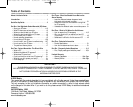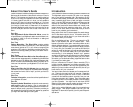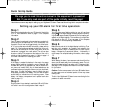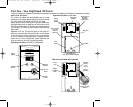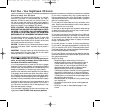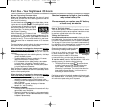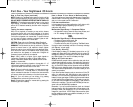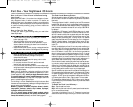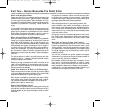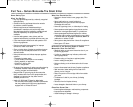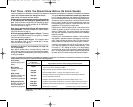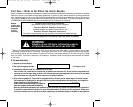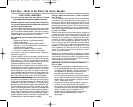
Part One – Your Nighthawk CO Alarm
Nighthawk’s Unique Features
Digital Display
The continuous digital display shows you the level of carbon
monoxide (if any) the unit is sensing. The unit updates this reading
every 15 seconds so you can watch levels rise or fall.
Note: If the unit does not sense any CO, the reading is zero (0).
In most homes, the unit reads “0” all the time. A reading of “0” is
expected under normal conditions, and is good. The blinking dot
after the number shows you the unit is operating.
Test/Reset Button
This button has three functions. First, this is the button you press
when you test the unit monthly (see page 1-5 for further details).
Secondly, you press this button if the unit alarms and you want to
silence the alarm. This will reset the unit and it will then again start
monitoring for CO, if CO concentration is above 70 ppm the alarm
will again sound within 6 minutes. It’s also used when resetting the
peak level memory. (See page 1-7).
Peak Level Button
By pressing this button, you can see the peak CO level recorded
by the alarm since it was last cleared or unplugged. This
Nighthawk feature allows you (or heating contractor or fireman) to
see exactly how big a CO problem you have so you can react
accordingly. (More on the peak level memory feature on page 1-7).
Sensor
The sensor is a highly sensitive, electrochemical sensor that is CO-
specific to help avoid false alarms. Turn to page 1-7 for more
information on how to care for and protect the alarm.
Sounder Alarm
This is the loud 85 decibel pulsing alarm that will sound to alert you
to a potential problem. Alarm condition is 4 quick beeps – followed
by 5 seconds of silence – followed by 4 quick beeps. Repeat.
Caution: Continuous exposure to this sound level at close range
over an extended period of time may cause hearing loss. We rec-
ommend you cover the sounder with your finger while testing.
More on testing on page 1-5,6.
Keyholes
When the alarm is mounted to the wall, these keyholes slide onto
the screws in the wall. (See “How to install your alarm on page 1-4).
Pull-Out Transformer/Adapter
This unique Nighthawk feature enables the alarm to be used as a
direct plug unit, a wall mounted unit or a table top unit. More on
how this unique feature is used for different application, page 1-4.
9V Backup Battery
This CO alarm is not battery operated. The 9V battery is to supply
a short-term backup during a power outage. In the event of a
power outage, the 9V battery will continue operating the alarm for
at least 20 hours.
What Carbon Monoxide Alarms Can and Cannot Do
CO alarms are designed to sense unacceptable levels of CO from
malfunctioning furnaces, appliances, gas engines or other
sources.
CO alarms provide early warning of the presence of carbon
monoxide, usually before a healthy adult would experience
symptoms.
This early warning is possible, however, only if your Nighthawk
CO alarm is located, installed and maintained as described in this
user’s guide.
This CO alarm is designed to act as a continuous
monitor, it is
not designed for use as a short-term testing device to perform a
quick check for the presence of CO.
CO alarms have limitations. Like any other electronic device, CO
alarms are not fool-proof.
CO alarms have a limited operational life. You must test your CO
alarm monthly, because it could fail to operate at any time. If
your CO alarm fails to test properly, or if its self-diagnostic test
reveals a malfunction, immediately have the unit replaced. See
back page for warranty information.
CO alarms will not work without power. This CO alarm requires
a continuous supply of electric power.
CO alarms can only sense CO that reaches the unit’s sensor.
Carbon monoxide may be present in other areas without reach-
ing the alarm. The rate at which CO reaches the unit may be
affected by doors or other obstructions. In addition, fresh air
from a vent or open window or any other source may prevent
CO from reaching the sensor. Please observe cautions on page
1-3 “Where to install your alarm.”
CO could be present on one level of the home and not reach a
CO alarm installed on a different level. For example, CO in the
basement may not reach an alarm on the second level, near the
bedrooms. For this reason, we recommend you provide com-
plete coverage by placing a CO alarm on every level of the home.
CO alarms are not smoke alarms. CO alarms do not sense smoke
or fire. For early warning of fire you must install smoke alarms,
even though carbon monoxide can be generated by a fire.
CO alarms should not be used to detect the presence of natural
gas (methane), propane, butane, or other combustible fuels.
CO alarms are not a substitute for property, disability, life or other
insurance of any kind. Appropriate insurance coverage is your
responsibility. Consult your insurance agent.
1-2
810-1368 AC PP 12/99 8/24/00 2:06 PM Page 7




